Welcoming a new member into the family is a wonderful experience for parents. As a new parent, making sure your little one is safe at home is super important. Babies and toddlers are always curious and exploring, so it’s crucial to be aware of potential dangers around the house. Childproofing isn’t just a one-time thing, it’s an ongoing process that changes as your child grows. Think safety gates, securing furniture, using corner protectors, and keeping small objects and harmful stuff out of reach. Creating a safe home environment lets your child freely explore and learn while giving you peace of mind as a parent.
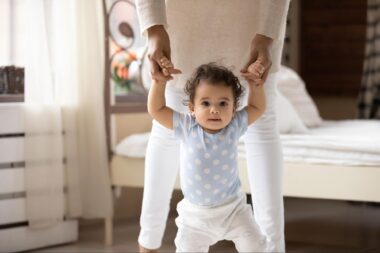
In the upcoming sections of this blog, we’ll dive deeper into essential childproofing tips and guidelines to effectively safeguard your home, creating a safe haven for your child. We’ll explore different rooms and common hazards, sharing practical knowledge and techniques to prevent accidents. So your little one can freely explore, play, and grow in a safe and secure environment.
Baby Safety Month
September is globally known as Baby Safety Month, a time to raise awareness about the crucial importance of keeping infants and toddlers safe at home. This month-long campaign, started by the Juvenile Products Manufacturers Association (JPMA), gives parents, caregivers, and safety advocates a chance to refocus their efforts and learn about the latest childproofing techniques and products that can prevent accidents. Baby Safety Month highlights the need for continuous education and vigilance in maintaining child safety, especially at home where many preventable injuries can happen.
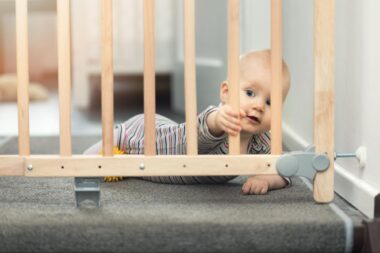
Assessing Your Home for Safety
Performing a thorough home safety assessment is a vital first step in childproofing your home. This process involves careful examination of every nook and cranny, taking a child’s perspective to identify potential hazards that could go unnoticed from an adult’s viewpoint. It’s important to get down on your hands and knees and observe your home from a toddler’s eye level. This can reveal unseen dangers like accessible cleaning supplies, loose electrical cords, or small objects that can be easily swallowed. Also, it’s essential to assess your home’s structures, furniture, and appliances. Your assessment should also extend to outdoor spaces such as gardens, pools, or patios. Remember, a thorough home assessment is not a task to rush through because even one overlooked hazard can have serious consequences.
Childproofing Basics
Childproofing, also known as baby-proofing, is the process of making an environment or object safer for children, particularly infants and toddlers. It involves identifying potential hazards in your home and taking the necessary precautions to prevent accidents. The main purpose of childproofing is to protect children from injuries such as falls, burns, choking, and poisoning by ensuring that children cannot access dangerous items. It involves simple steps such as using safety gates, securing furniture, covering electrical outlets, and keeping small objects out of reach. Childproofing is essential as it creates a safe space where children can explore, learn and play, minimizing the risk of accidental injuries. It gives parents peace of mind knowing their child is safe, especially during those early years when curiosity and mobility increase.
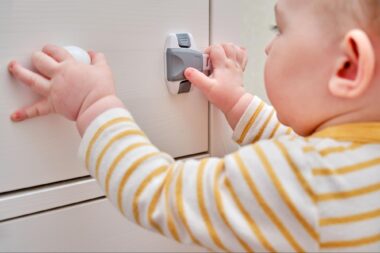
Common Childproofing Tools and Products
When it comes to childproofing, there are a number of tools and products available in the market that can significantly enhance the safety of your home.
-
- Outlet Covers: Electrical outlets are often at a perfect height for curious crawling infants or toddlers. Outlet covers are designed to prevent children from sticking their fingers or objects into sockets, reducing the risk of electrical shocks. They are typically easy to install and remove for adults, but challenging enough for children to detour their curiosity.
- Cabinet Locks: Cabinet locks are essential for keeping cleaning supplies, medicines, or sharp objects out of children’s reach. These locks can be easily installed on cabinet doors and drawers and are difficult for young children to figure out, providing an extra layer of security.
- Corner Guards: Furniture with sharp corners pose a risk of injury, especially for children who are just starting to walk or run. Corner guards are a great solution to this problem. They are designed to fit onto the sharp corners of furniture, reducing the risk of injuries in case of accidental bumps.
- Safety Gates: These are essential tools in childproofing homes with stairs. Safety gates are designed to prevent children from entering dangerous areas or falling down stairs. They are usually adjustable and can fit in most doorways or staircases.
- Furniture Straps: These are used to secure heavy furniture, like bookcases and television stands, to the wall. They prevent the furniture from tipping over if a child tries to climb on it.
- Toilet Locks: These prevent children from opening the toilet lid, protecting them from a potential drowning hazard and keeping the bathroom more sanitary.
- Door Handle Safety Locks: These are very important to avoid closets/stairs/or rooms in the house children should not venture into.
Using these tools and products can significantly improve the safety of your home for your little ones. Nonetheless, it’s important to remember that no product can replace careful supervision. Childproofing is an ongoing process that adapts with your child’s growth and developing abilities.
Best Practices for Installing and Using Childproofing Items Effectively
When it comes to childproofing, correct installation and usage of safety tools play a pivotal role. Here are some best practices to ensure maximum safety:
- Read and Follow the Instructions: Each childproofing product comes with its own set of instructions. Ensure to read them thoroughly and follow them diligently. Incorrect installation can lead to ineffective childproofing, despite having the right tools.
- Regular Maintenance Checks: Routinely check all safety devices to ensure they are still securely fastened and working correctly. Over time, wear and tear or the playful curiosity of a child may weaken or damage these devices.
- Prioritize According to Age and Mobility: Different stages of your child’s development present different hazards. Prioritize safety measures according to your child’s age and mobility. For instance, outlet covers become more crucial when your baby starts crawling, while safety gates become essential when your child starts walking.
- Don’t Rely Solely on Childproofing Tools: Remember, no childproofing tool can substitute for adult supervision. Always keep an eye on your child, especially in areas like the kitchen and bathroom, irrespective of the childproofing measures in place.
- Educate and Involve Your Child: As your child grows, educate them about potential dangers in the house. Involve them in safety procedures to foster understanding and cooperation. This also helps them to understand the purpose of these safety tools.
By following these best practices, you can make the most out of your childproofing items and create a safer home environment for your child to grow and explore.
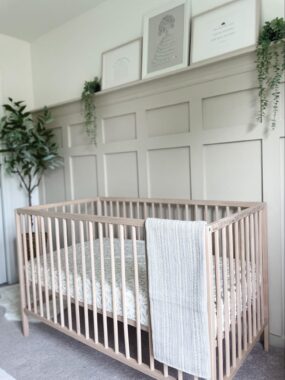
Nursery Safety
Nursery safety is a critical aspect of childproofing that deserves special attention. This is the space where your child will be spending a significant amount of time, especially during the early years. It’s not just about creating a warm and comforting environment, but also about ensuring that it is safe and secure. To childproof the nursery, consider the following:
- Crib Safety: Make sure the crib meets current safety standards and its bars are spaced no more than 2 3/8 inches apart to prevent your baby’s head from getting stuck. The mattress should fit snugly within the crib, with no spaces at the sides. Never place pillows, large stuffed toys, or heavy blankets in the crib as they pose a risk of suffocation.
- Changing Table Safety: Ensure the changing table is sturdy and has a safety strap to secure your baby. Always keep one hand on your child while they’re on the table to prevent falls.
- Furniture Safety: Anchor all furniture to the wall to prevent it from tipping, even if it seems too heavy for your child to move. This includes dressers, bookcases, and any other large furniture pieces.
- Toy Safety: Only use toys that are suitable for your child’s age and development level. Keep small toys, or those with small parts, out of the nursery to prevent choking hazards.
- Window Safety: Install window guards or stops to prevent falls, and keep cribs and other furniture away from windows to deter climbing.
- Electrical Safety: Use outlet covers on all unused electrical outlets to prevent shocks from poking fingers or objects into sockets.
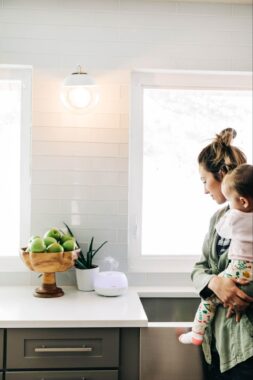
Kitchen and Bathroom Precautions
The kitchen and bathroom pose unique challenges when it comes to ensuring baby safety. Kitchens are filled with potentially dangerous items like knives, hot surfaces, and heavy pots, while bathrooms have hazards like water-filled bathtubs and cleaning chemicals.
- Kitchen: In the kitchen, keep knives and other sharp tools out of reach and secure oven doors with appliance latches to prevent burns. Also, use stove knob covers to prevent little ones from turning on the stove unintentionally. Store cleaning supplies in locked cabinets, and always supervise your child in the kitchen.
- Bathroom: In the bathroom, install toilet locks to prevent accidental drowning and keep toiletries and cleaning supplies in locked cabinets. Use non-slip mats in the bathtub and always monitor your child during bath time. Never leave standing water in the tub or buckets as they pose a drowning risk. Also, consider adjusting your water heater to a maximum of 120 degrees Fahrenheit to prevent scalding. By taking these precautions, you can significantly enhance safety in these challenging areas of your home.
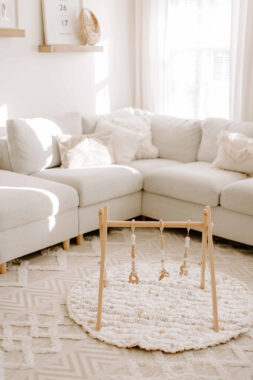
Living Room and Common Areas
- Furniture: The living room and common areas are usually filled with furniture like couches, coffee tables, and bookcases. To ensure safety, use corner protectors to cover sharp furniture edges and corners. Also, secure tall or heavy furniture to the wall with furniture straps to prevent any risk of them tipping over on your child. Remember to keep climbable furniture away from windows or other dangerous areas.
- Electronics: Electronics, such as televisions and stereo equipment, should be positioned so they’re secure and can’t easily be pulled down. Consider mounting flat-screen TVs to the wall and placing heavier, older model televisions on low, sturdy pieces of furniture. Use cable management systems to organize and conceal cords, eliminating the temptation for your child to pull at them.
- Cords: Electrical and window cords pose significant safety risks. Secure all electrical cords out of your child’s reach and cover outlets when not in use. For window blind cords, use cord cleats or cordless window coverings to prevent choking hazards. Always keep these cords out of a child’s reach.
Creating safe play zones within the home’s common areas is a crucial part of childproofing. These zones provide a designated area for your child to play, explore, and learn, significantly reducing the risk of accidents or injuries. Use safety gates to enclose these play zones. They restrict your child’s access to potentially dangerous areas, such as staircases, fireplaces, or kitchens. Ensure these gates are sturdy and difficult for a child to climb or open. Consider using soft, cushioned mats or carpeted areas for play zones, which can help prevent injuries from falls. Even with a designated safe play zone, never leave your child unattended. Active supervision is the most effective way to prevent accidents.
By addressing these concerns, you can make your living room and common areas much safer for your child to play and explore.

Emergencies and First Aid
Preparing a well-equipped first aid kit is a crucial step in ensuring the safety of your child. The kit should be easily accessible and regularly checked to replace expired items. Here’s what you should include in your first aid kit:
- Bandages
- Sterile gauze
- Adhesive tape
- Antiseptic wipes or solution
- Tweezers
- Digital thermometer
- Infant paracetamol and ibuprofen
- Saline solution
- Hydrocortisone cream: To relieve itching from insect bites or rashes.
- A first-aid manual or instruction booklet
Furthermore, you should consider taking a pediatric first aid course. Knowing what to do in an emergency can make all the difference while waiting for professional medical help. Lastly, always keep emergency numbers, including your pediatrician’s number, near your home phone or stored in your cell phone for quick and easy access.
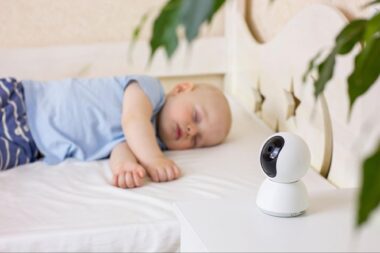
Continuous Monitoring and Adaptation
Child safety is a dynamic process that requires continuous monitoring and adaptation. As your child grows and develops, so do their abilities and interests, and what was once a safe environment can quickly become filled with new hazards. Regularly revisiting and updating your childproofing measures is essential. For instance, a baby who’s just started crawling may not have been able to reach certain items that a toddler can. Checking the stability of your furniture anchors, the functionality of safety gates, and the integrity of outlet covers periodically could help prevent accidents. Also, with age, children might learn how to unlock certain safety locks, so constant reassessment of their effectiveness is crucial. By staying vigilant and adaptable, you can ensure that your home remains a safe space for your child at every stage of their development.